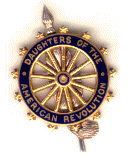

|
|
Deborah Samson was born on Dec 17, 1760 to John and Deborah Samson. The
family could trace their lineage to the Mayflower on both sides including such
notables as Priscilla Alden and Myles Standish. Deborah was the eldest of 3
daughters and 3 brothers. When Deborah was about 5 yrs old, her father left to go
to sea and was supposed to have died at sea. Later day research shows that he
simply walked out on his family and created a new life in Maine. This left the
Samson family with 6 mouths to feed and Mrs. Samson was in poor health. She
fostered the children for a while, but at the tender age of 8 or 10 Deborah was
placed in indentured servitude with the kind, but large family of Jeremiah Thomas of
Middlesborough. The Thomas family had no girls, but lots of boys and Deborah was
responsible for taking care of them and getting them ready for school. She read the
boys' school books at night and succeeded in learning enough this way that when she
turned 18 and was freed she obtained a position as schoolteacher in
Middlesborough. All the time she spent with the Thomas Family and afterwards was spent
among the growing tension between the British and the Colonists. It was during this
time that the Stamp Act was placed into effect, and revolutionary thinkers such as
James Otis and Samuel Adams were starting to show the colonists that they didn't
need the British to protect them, that in fact the colonies could protect themselves.
Deborah watched as the British attempted to halt the rebellious talk and acts by
closing the port of Boston and quartering troops in private homes. She watched as
the "intolerable acts" were put into effect and she heard the news of the stand in
Lexington and Concord that fateful April day. She heard the reading of the
Declaration of Independence and she watched the young colonists get their first
REAL taste of war. She was not frightened by this, her only question was "Why can
I not fight for my country too?", a question which was to be repeated during every
US war until after the Persian Gulf War in this Decade. Deborah finally decided that
to do her duty to her country she would dress up as a man and enlist. Her first
attempt was in 1782 but after signing the enlistment papers to join the American
Army, she had a change of heart and did not show up the next day. A while later in
1782 she firmed her resolve and attempted again to enlist in the military. She, on
May 20, 1782, signed up to join the 4th Massachusetts Regiment using the name
Robert Shurtleff. Her disguise worked and she was mustered into Captain George
Webbs Co. Her local church hearing rumors of her "Unchristian" like behavior of
wearing men's clothing and joining the army, decided shortly after her company left
the Boston area, to excommunicate her. Such was often the price for individualist
thinking. Deborah's company though was going to lower New York where while
Washington held the area, many small guerilla attacks were still happening.
Deborah's company was charged with assisting to halt those attacks. During one of
the particularly bloody engagements in Tarrytown, NY, Deborah, while attempting to
retreat, was wounded in the head and then the thigh. She was escorted to a field
hospital where her head wound was treated. She did not tell the doctor about the
musket shot in her leg for fear of discovery. She tried to treat the wound herself, but
lacking the strength to dig the musket ball out, she left it there and as such her leg
never healed properly. She, after many weeks, healed enough to return to active
duty. During this time though she was to come down with a fever and the doctor
while treating her, discovered her secret. He had her removed to his house and
personally oversaw her treatment, all the while keeping her secret. After Deborah
was healed he secretly passed her secret on to a General at Fort Knox who then
honorably discharged her on October 23, 1783, while publically keeping her
secret. Deborah when talked about as Robert, was thought of as a great soldier,
with endurance and courage, something much needed in the military at that time. The
war had been long and hard. After the war she met and married Benjamin Gannet.
Although a good marriage, it was a poor marriage. The Gannets often had to borrow
money. Paul Revere, a good friend of Deborah, upon hearing this, petitioned the
Massachusetts government to provide her with back pay and interest to the sum of
37 pounds. This was not enough to ease their financial woes, so Deborah took to
the lecture circuit. She was the first female lectern. She would travel from city to city
and give lectures about her experience as a soldier in the war, wearing her uniform
and such. This while better still was not enough, so in the early 1800's she was
awarded a veterans pension of 4 dollars a month. This pension was eventually
awarded to her husband as a survivor pension after Deborah died on April 19,
1827 in Sharon, Mass. She was 67 years old and had 3 children. Deborah is
now the official Heroine of the State of Massachusetts and there is even a chapter of
DAR named after her. She was a true American Hero. Written by Mrs. Todd James.
|
![]()
